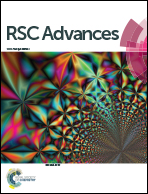Recovery of acetone from aqueous solution by ZIF-7/PDMS mixed matrix membranes†
Abstract
Metal–organic frameworks (MOFs) have exhibited promising applications in gas and liquid separation. As a subclass of MOFs, zeolitic imidazolate frameworks (ZIFs) are attracting more and more interest because of their unique thermal and chemical stability. One of the representative ZIFs, ZIF-7, has super-hydrophobic pores, making it a perfect filler in polymer membranes for recovering acetone from fermentation broths. In this study, mixed matrix membranes (MMMs) based on ZIF-7 and polydimethylsiloxane (PDMS) were prepared, which display improved acetone–water total flux and separation factors simultaneously compared with a pure PDMS membrane. The separation factor can reach up to 39.1 with a high flux of 1236.8 g m−2 h−1 at 333 K, which is the highest value among those reported up to now to the best of our knowledge.


 Please wait while we load your content...
Please wait while we load your content...